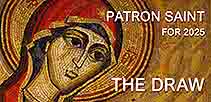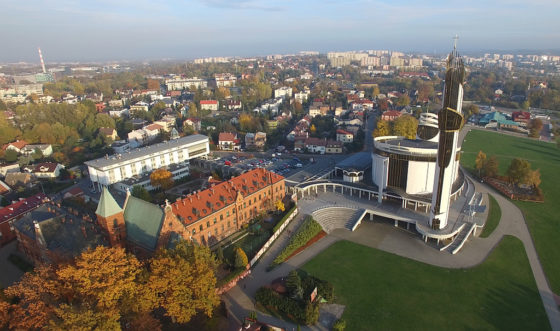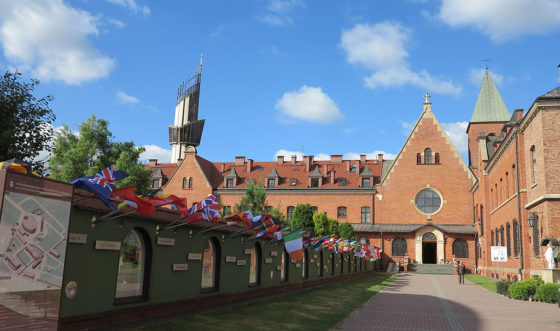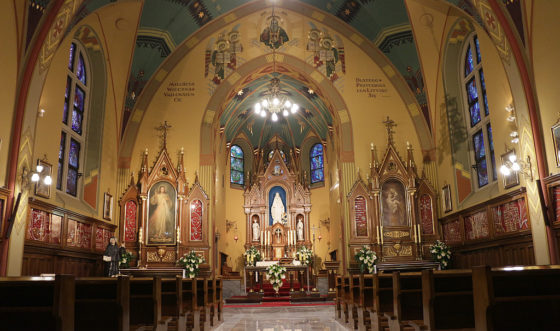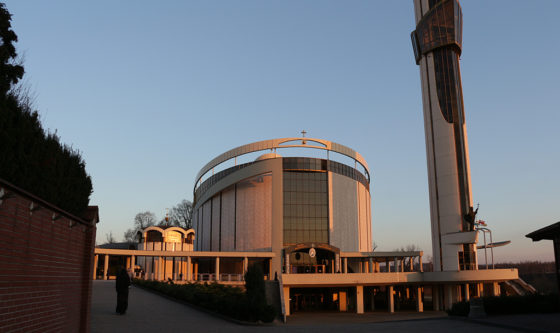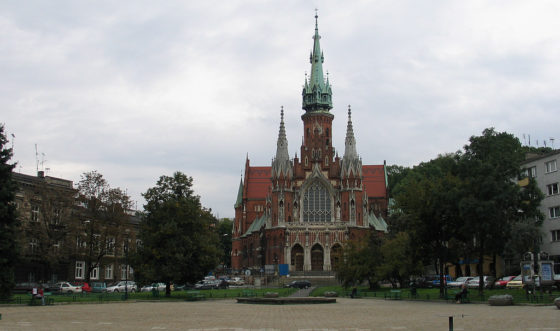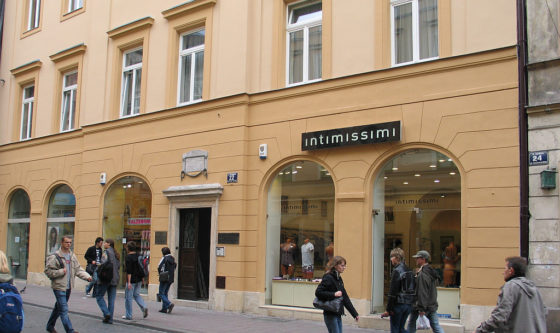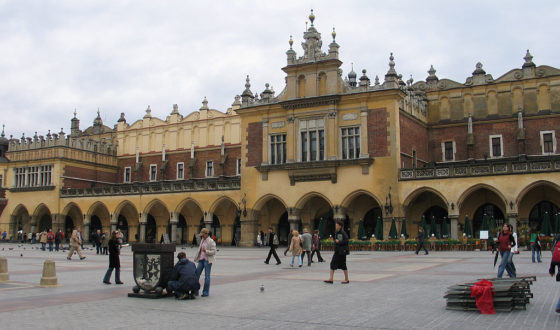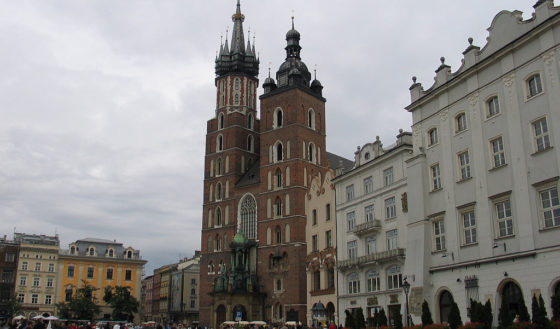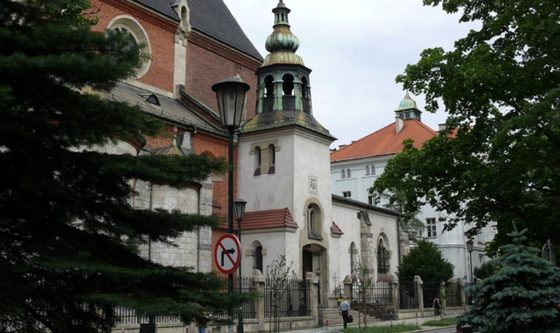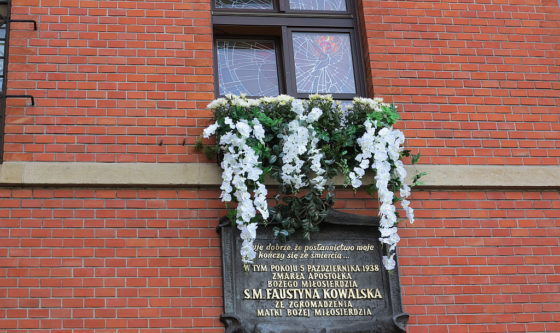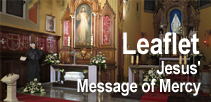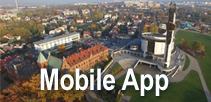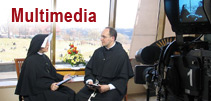The St. Faustina Route in Kraków
The St. Faustina tourist route in Kraków was established through cooperation between the Congregation of the Sisters of Our Lady of Mercy and the Tourism Office at Kraków’s City Hall, and was first followed on 17 September 2008. This route includes: the Shrine of The Divine Mercy in Kraków-Łagiewniki; St. Joseph’s Church in the Podgórze district; St. Mary’s Basilica in the Main Market Square; the Basilica of the Sacred Heart in Kopernika Street; Szewska Street; and the John Paul II Hospital in Prądnicka Street (Szpital Jana Pawła II). The Kraków City Hall published the brochure “In the Footsteps of St. Faustina in Kraków” in English, Italian and Polish, to assist with the pilgrimages of the many devotees of the Merciful Jesus and of His “secretary”, as well as introducing tourists to the best traditions of the Kings’ City.
Mapa
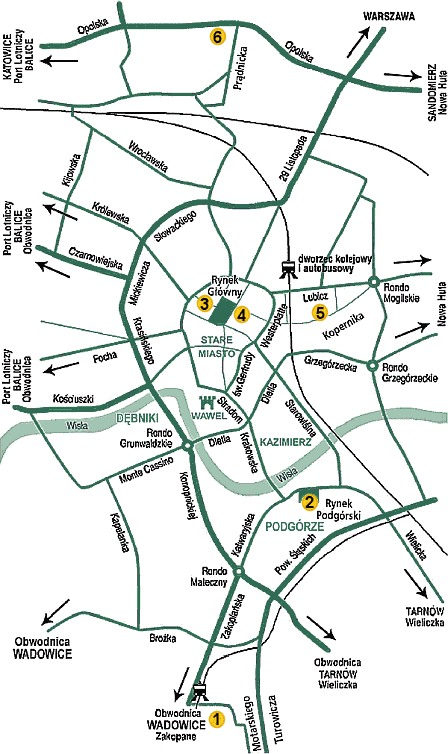
1. The Shrine of The Divine Mercy
The St. Faustina Route in Kraków starts at the Convent of the Congregation of the Sisters of Our Lady of Mercy, where St. Faustina lived for over five years and where her relics lie. Today this place, along with new buildings, is known as the Shrine of The Divine Mercy and is an extremely dynamic centre of devotion to which pilgrims come from around the world. The Holy Father John Paul II came here twice, in 1997 and 2002, and also the Holy Father Benedict XVI in 2006. In terms of the number of countries from which pilgrims come, the Shrine in Kraków-Łagiewniki occupies a leading position among all the shrines of the world.
“Yet even though time and the entire world may be considered his ‘temple’, God has chosen certain times and places to enable people to experience in a special way his presence and his grace. Impelled by their sense of faith, people journey to these places, confident that there they will truly find themselves in the presence of God. In this same spirit of faith I have come to Łagiewniki to dedicate this new church. I am convinced that this is the special place chosen by God to sow the grace of his mercy.”
(John Paul II, 17 August 2002)
1 a. The Convent Buildings and Complex
in Kraków-Łagiewniki
The convent buildings date back to the late nineteenth century. They were built with funds from Prince Aleksander Lubomirski, financier and philanthropist, and designed by architect Karol Zaremba. The chapel and convent buildings were consecrated by Cardinal Albin Dunajewski in 1891. The Sisters of the Congregation of Our Lady of Mercy started to live there along with those in their care, namely girls and women in need of profound moral renewal (Magdalenas). The Sisters based their work with them on respect for human dignity, nurturing Christian values and preparing them for employment and for a self-reliant, dignified life in society. In this “House of Mercy”, as the Congregation’s apostolic institutions were called, the Sisters ran the following workshops to a very high standard: embroidery and weaving service workshops, a bindery, and a laundry; horticulture and farming were also taught. Because of the delicate nature of this “work of mercy” carried out by the Sisters, the convent was kept closed to outsiders until World War II.
During the First World War, part of the convent property was seized for use as a military hospital for soldiers of different nationalities, suffering from infectious diseases. Those who died were buried in the cemetery behind the wall of the convent, now behind the basilica and known as “the soldiers’ cemetery”. During the Nazi occupation the sisters continued to run “The House of Mercy”, to which the Germans, for disciplinary reasons, directed women caught smuggling. The sisters helped the displaced, and were active in “underground” teaching and in charitable works including a kitchen for the poor. In 1962, Communist authorities confiscated the Congregation’s educational institution and most of the property. Several years later, in 1969, the Sisters organized, in the convent, an open care centre for socially difficult youth called Źródło (Source), and this ran until 1991. After the collapse of communism, in 1989, the state authorities gave the Congregation back their facility for girls. Today it is called Młodzieżowy Ośrodek Wychowawczy (Youth Educational Centre), and is a closed centre, a rehabilitation facility for socially maladjusted girls. Here the Sisters run a dormitory; one secondary school for ages 12-15; and three secondary schools for ages 16-19: the first being a 3-year secondary finance and administration school; the second a 2-year vocational catering school and the third a 2-year vocational hairdressing school.
The Congregation of the Sisters of Our Lady of Mercy, has come to recognize St. Faustina as its spiritual co-founder and so its Sisters proclaim the message of Mercy, not only through the witness of their lives and their work of mercy for those in need of moral renewal, but also by their prayers and by spreading the message. This “work” covers serving the pilgrims; forming the Apostles of The Divine Mercy in the “Faustinum” Association; producing the publications of the “Misericordia” Publishing House and the quarterly “Message of Mercy”; and using the mass media.
1 b. The Chapel of the image of Merciful Jesus,
famous for its graces, and the tomb of St. Faustina
The chapel of St. Joseph, which joins the two wings of the convent buildings, was consecrated by Cardinal Albin Dunajewski on 20 August 1891. In the central place at the main altar, stands a statue made by an unknown sculptor of Przemyśl, a statue of Our Lady of Mercy, the Patron of the Congregation, while on the left side stands St. Stanisław (patron of young religious) and on the right St. Mary Magdalene – the patroness of penitents. The altar to the left of the chancel has the miraculous image of Merciful Jesus, covering the image of the Sacred Heart originally placed there. On the right of the chancel is a picture of St. Joseph with the Child, painted by Father Krudowski.
During World War II, the convent building in Łagiewniki (previously closed to people from outside) was opened for refugees and people seeking to visit the tomb of Sister Faustina, as the fame of her saintly life grew alongside an ever increasing the devotion to The Divine Mercy. On 7 March 1943, Father Joseph Andrasz SJ, the Kraków confessor of Sister Faustina, blessed the first image of the Merciful Jesus painted by Adolf Hyła, and initiated solemn services in honour of the devotion to The Divine Mercy, these attracting crowds from Kraków and the surrounding area. The second image of Merciful Jesus by A. Hyła, which corresponded in size and shape to the recess at the side altar, was blessed by Father Joseph Andrasz on the first Sunday after Easter (the Feast of Mercy) on 16 April 1944 and quickly became famous for the miracles and graces bestowed there. Copies and reproductions of this image spread throughout the world, fulfilling the command of Jesus to Sister Faustina, that the image of His mercy be venerated first in the chapel of the Congregation and then throughout the world.
Historic paintings on the walls were designed in the interwar period (1934) by Zdzisław Gedliczka. They were renovated during the general renovation and restoration of the chapel in the years 1981-1990. At that time, stained glass windows, the work of Wiktor Ostrzołek, were set in the side windows of the chapel and in the porch. The only earlier one is that of St. Cecilia, in the round window in the choir. On the walls around the chapel hang display cases containing artistically arranged votive offerings testifying to the graces petitioned for and received by pilgrims praying at this place.
In 1968 the chapel was entered on the list of shrines within the diocese of Kraków, and on 1 November 1992 the Cardinal Archbishop of Kraków, Franciszek Macharski, issued a formal decree establishing it as the Shrine of The Divine Mercy. In front of the chapel there is a bas-relief bust of Pope John Paul II, designed by Prof. Czesław Dźwigaj, commemorating the Pope’s first papal pilgrimage to the Shrine in Łagiewniki on 7 June 1997, and on the other side there is a plaque, designed by Andrzej Zaradkiewicz, commemorating the pilgrimage of Pope Benedict XVI on 27 May 2006. On the convent building, at the entrance to the chapel, there is also a plaque designed by Czesław Dźwigaj, which points to the cell, the former convent infirmary, where St. Faustina was called home to the Lord.
1 c. The Basilica of The Divine Mercy
The beatification and canonization of St. Faustina, and the three papal pilgrimages led to the rapid development of the Shrine. Karol Wojtyła played a huge role in this, as priest, as shepherd of the Diocese of Kraków, and as Pope; as did Cardinal Franciszek Macharski, the Archbishop of Kraków, who established the Foundation aimed at the construction of the Basilica of The Divine Mercy together with facilities for pilgrims. On 17 August 2002, the Holy Father John Paul II consecrated the new basilica and there he entrusted the whole world to The Divine Mercy.
Built according to the design of Witold Cęckiewicz, the basilica resembles a ship symbolising a contemporary “ark of God’s covenant with Noah”, in which everyone who puts their hope in the mercy of God can find salvation. In the chancel behind the large stone altar there is a tabernacle surrounded by a bush tossed by strong winds, symbolizing the modern world or man confused by different currents of opinion. Within the bush above the tabernacle stands the image of Merciful Jesus, a copy of the Jan Chrząszcz’ image of the Merciful Jesus in Whom mankind will find happiness. To either side of the chancel, on the walls that form part of the nave, you find facing you on the left the image of Our Lady of Mercy of the Gate of Dawn by Jan Chrząszcz; and on the right, words spoken by the Holy Father John Paul II in this basilica on 17 August 2002 as a part of the act of entrusting the world to The Divine Mercy. At the entrance to the basilica there is the cornerstone from Calvary, consecrated by the Holy Father John Paul II, and a plaque commemorating the second pilgrimage of the Holy Father John Paul II to Łagiewniki and the consecration of the basilica.
Five chapels are located in the lower part of the basilica: Communio Sanctorum Chapel with a beautiful mosaic design of the Hungarian artist, a Greek Catholic (Uniate) priest, László Puskás, (a gift from the Hungarian Church); St. Faustina’s Chapel with the image of The Divine Mercy Apostle by Jan Chrząszcz (funded by the Italians); the Chapel of St. Andrew the Apostle with the iconostasis of the Ukrainian artist Lubomir Medwid (funded by the Greek Catholics (Uniate) from Poland and Ukraine); Our Lady of Sorrows Chapel (funded by the Slovaks); and Holy Cross Chapel (funded by the Germans).
The Chapel of Perpetual Adoration, built and designed by Witold Cęckiewicz, is situated next to the basilica. In this chapel there is Perpetual Adoration of the Blessed Sacrament and the fire of Mercy is kept burning, the fire lit by John Paul II as a sign of the message of The Divine Mercy radiating from this place to the whole world. In the immediate vicinity of the basilica there is the John Paul II Hall, and in front of the basilica a freestanding observation tower with a monument of the Holy Father John Paul II, the Apostle of The Divine Mercy and the advocate of peace.
2. The Church of St. Joseph in Podgórze District
The Church of St. Joseph is the largest one in Podgórze, which until 1915 was a separate town, situated on the other side of the Vistula River. It was founded in 1784 as a garrison town but also competed with Kraków for trade and manufacture. The church in Podgórze was built in the period 1905-1909 in place of another church demolished due to threat of collapse. The new church in the neo-Gothic style was designed by Jan Sas-Zubrzycki. The church’s interior was designed following the pattern of Gothic cathedrals, in the version of this style known as Vistula Gothic (gotyk nadwiślański). The church houses numerous altars placed in the aisles and chapels. At the main altar, designed by the architect of the church, there is the altar itself (mensa), the tabernacle and a statue of the patron saint of the church – St. Joseph – sculpted by Zygmunt Langman.
The Church of St. Joseph in Podgórze is the parish church to which the village Łagiewniki once belonged. One event recorded in the pages of the “Diary” is linked with this church. Namely, on 27 December 1937 St. Faustina was returning by carriage to the hospital in Prądnik and she wrote: “I had a pleasant journey, as I was accompanied by a certain person who was taking her baby to be baptised. We took her right up to the church in Podgórze; and when she was about to alight, she gave me the baby to hold. When it was in my arms, I prayed ardently, offering it up to God, so that one day it may bring special glory to the Lord; in my soul felt that the Lord had cast a special glance at this little soul” (Diary 849). The night before, someone had left this child by the convent gate in Łagiewniki. In the morning the sisters found the child, bathed and fed it and looked for someone who would take it and bring it up. A neighbour offered her help and eagerly adopted the foundling child; and she wished to register the child in her name. It was for this the carriage was being used, which took Sister Faustina to Prądnik; therefore she travelled with the neighbour and the foundling child, so as to have it baptized in the parish church and make the entry in the church Register of Births.
3. The Cebulski Publishing House in Szewska Street
Szewska Street connects the west side of the Main Market Square with Podwale Street, a former suburb of Kraków called Garbary, with mills and the royal fullers mills. The buildings in Szewska Street date mainly from the sixteenth and seventeenth centuries. The historic tenement house at 22 Szewska Street, referred to as a ‘collegiate’ house, was rebuilt in 1910 from two old tenement houses that had previously been built by the Collegiate Church of St. Anne in 1636. Józef Cebulski rented a part of this building for his company, which operated under the name: Publishers of Devotional Books and Repository (Wydawnictwo Książek do Nabożeństwa i Skład Dewocjonalii).
This Publishing House in Kraków printed the first images of the Merciful Jesus with the Chaplet of The Divine Mercy and small prayer books entitled: “Christ, King of Mercy”, which Fr. Michał Sopoćko, Vilnius spiritual director of St. Faustina, put together based on her revelations. St. Faustina along with her superior, Mother Irena Krzyżanowska, was in this Publishing House on 27 September 1937. She described this event in her “Diary”: “Today, Mother Superior and I went to see a gentleman [at a shop] where our small prayer cards of the Divine Mercy were being printed, along with the [brochure with] prayers and the Chaplet, which has now been approved; we also had the opportunity to see the big picture after it had been improved. It’s a good likeness, so I was very pleased”(Diary 1299; cf. Diary 1301).
4. The Main Market Square
After the visit to Cebulski Publishing House with superior Mother Irena Krzyżanowska, Sister Faustina went to St. Mary’s Church. She would certainly have walked across the Main Market Square, which dates back to the 13th century and is the largest medieval city square in Europe, laid out when in 1257 the city was granted a municipal charter under the Magdeburg Law. For centuries the function of the Main Market Square was primarily commercial with a number of stalls, the city weigh house and granary. The Cloth Hall is still there to remind us of what went on in the Main Market Square. The Cloth Hall’s present architecture is owed to outstanding architects of the sixteenth century such as Jan Maria Padovano and Santi Gucci, and also to Tomasz Pryliński, who was responsible for its latest reconstruction in the second half of the nineteenth century. Since the nineteenth century the Cloth Hall has served not only commercial but also cultural purposes, as it is the site of the National Museum, the first Polish public museum, founded at the time of the partitions (in 1879).
Solemn entries of monarchs, tributes made to kings, parades and processions have all been celebrated at the Main Market Square … The Market Square was located on the Royal Route, and therefore witnessed solemn entries of the king and foreign legations, and many grand celebrations, historical state and church events; among these were the Prussian Homage (1525), the oath of Tadeusz Kościuszko (1794), the entry of Prince J. Poniatowski (1809), the Eucharist with the Holy Father John Paul II, the “white march” after an attempt on his life, and the entry of Cardinal Stanisław Dziwisz, the Archbishop of Kraków. Surrounding the Market Square are many magnificent palaces, formerly owned by merchants and aristocratic families.
Walking across the Market Square St. Faustina could not fail to notice the characteristic Gothic Town Hall Tower, the sole remaining feature of the old town hall; and also St. Adalbert’s Church (St. Wojciech), which according to tradition, was built in the place where this saint preached. This is one of the oldest churches in Kraków, built in the eleventh century, and rebuilt in the baroque style in the early seventeenth century. During the summer the Archeological Museum holds an exhibition in the vault of the church, showing the unusual discoveries made during construction and installation work on the Main Market Square.
4. St. Mary’s Basilica
The Church dedicated to the Assumption of the Blessed Virgin Mary, in the Main Market Square in Kraków, is the most famous gothic church in Poland and, after the cathedral, the second church in Kraków to serve as the parish church of the city. Built in the early thirteenth century on the initiative of Bishop Iwo Odrowąż, the church was rebuilt and beautified over the following centuries. The church houses many great objects of historical value, samples of Gothic, Renaissance and Baroque art. The basilica is adorned by two great towers: the higher gilded with the crown (81 meters high) and the lower one (69 meters high), which has always served as a belfry. Since the fourteenth century a bugle call has been played every hour from the higher tower, which served as a watchtower. As the parish church, St. Mary’s Church was under the care of the residents of Kraków, which is why the ambition of the richest middle-class families was to have their own chapel here. Inside the basilica are several chapels, and many altars. The St Mary’s Altar carved by Wit Stwosz, a magnificent historic monument of medieval woodcarving, is a jewel of the Church. This is the biggest altar of its kind in Europe (11×13 m) made of oak and lime wood (sculptured figures). At the altar itself, in the central part, is a very vivid scene of The Virgin Mary having fallen asleep surrounded by Apostles, and in the apse is the scene of the Assumption and Coronation. The side panels show the six scenes of the Joys of Mary from the Annunciation to Pentecost. With the wings closed twelve scenes of the Sorrows of Mary can be seen. The polychrome staining of the chancel and the church is the work of Jan Matejko, who was helped by Józef Mehoffer and Stanisław Wyspiański.
In the “Diary” St. Faustina describes her visit and spiritual experiences in this church: “When we had finished the whole business, we went to the Church of the Blessed Virgin Mary and attended Mass, during which Jesus let me know what a great number of souls would be saved thanks to this work. Then I entered an internal conversation with the Lord, thanking Him for having granted me the grace of seeing the praise of His unfathomed mercy growing. I entered into a profound prayer of thanksgiving. O, how great is God’s generosity, blessed be the Lord, Who is true to His promises…” (Diary 1300).
5. The Basilica of the Most Sacred Heart of Jesus
The Sacred Heart Church in 26 Kopernika Street in Kraków was built according to the design by Franciszek Mączyński in the years 1912 to 1921. Famous sculptors were engaged for the interior design of the church (Xawery Dunikowski, Karol Hukan) and painters (Jan Łukowski, Piotr Stachiewicz, Leonard Stroynowski). The chancel is decorated with a mosaic frieze by Piotr Stachiewicz depicting a scene of homage, honour and worship for the Sacred Heart of Jesus by Polish saints and the beatified, and by all social classes and states of life.
On 28 May 1921, in the presence of many ecclesiastical and secular dignitaries, the ceremony of the consecration of the church began with the bringing in of the relics of the saints: namely those of St. Adalbert (Wojciech) and St. Stanisław, bishop and martyr. The next day the church was consecrated by Bishop Anatol Nowak, and several days later on 3rd June, the liturgical feast of the Sacred Heart of Jesus, the Primate of Poland, Cardinal Edmund Dalbor, surrounded by bishops, clergy and thousands of the faithful, led the procession from the Church of the Sacred Heart to the Small Market Square in Kraków, where he solemnly dedicated Poland to the Most Sacred Heart of Jesus. In 1960, under the breve of Pope John XXIII, the Church in Kopernika Street, which was to function as a central church of the Sacred Heart for the Poles, was raised to the rank of a Minor Basilica.
At the time of Sister Faustina, Convents of the Congregation of Our Lady of Mercy were contemplative-active. Sisters would very rarely go to the city and only on important matters, for example for processions organized by the Jesuit fathers on the Feast of the Sacred Heart. Sister Faustina certainly took part in the procession of 19 June 1936. She noted in her “Diary” – “When we went to the Jesuits for the Sacred Heart procession, during Vespers I saw rays coming out of the Most Blessed Host the same as those painted in the picture. My soul was filled with longing for God” (Diary 657). It should also be added that the priests of the Society of Jesus were confessors and retreat preachers in the convents of the Congregation of Our Lady of Mercy. Sister Faustina was brought up on the spirituality of this order and with the Jesuits’ formation support. First Father Edmund Elter played an immensely important role in her life, and then Father Józej Andrasz, who was her confessor and spiritual director in Kraków.
6. The John Paul II Hospital in Prądnik 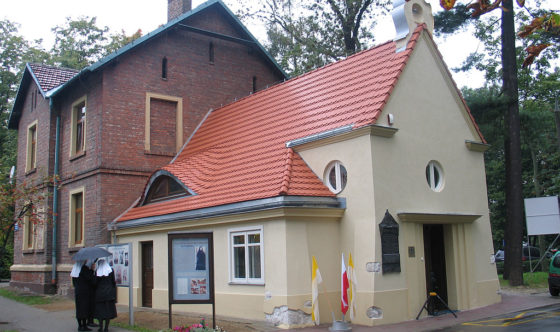
The Municipal Hospital in Prądnik Biały was founded in the years 1913–1917 following a resolution made by the Kraków City Council. The construction was based on the designs authorised by city doctor T. Janiszewski, the first general manager of the Hospital, and by the famous Kraków architect Jan Zawiejski. The chapel, located in a separate building, was designed in the modernist style by A. Szyszko-Bohusz or F. Mączyński. At the time it opened the infirmary accommodated 120 beds for patients with scarlet fever and 126 for patients with tuberculosis.
The Holy Father John Paul II was patron of the hospital from 1990, and on 9 June 1997 he blessed its newly-built Cardiac Surgery Clinic. Today the John Paul II Hospital is a modern medical complex, which sees the realization of many projects aimed at improving knowledge and extending practical services not just in the area of treatment but also in the area of prevention. In 2007 an architectural competition was announced for the extension of the Hospital using European Union funds under the “Help and Hope” project. As part of this project the Most Sacred Heart of Jesus Chapel, where St. Faustina prayed, has been thoroughly refurbished and the pre-war décor restored. The chapel was consecrated by the Archbishop of Kraków, Cardinal Stanisław Dziwisz, on which occasion the Congregation of the Sisters of Our Lady of Mercy donated a relic of Saint Faustina. A commemorative plaque designed by Czesław Dźwigaj was mounted in the outside wall of the chapel in remembrance of St. Faustina’s stay at the hospital, and a special commemorative inscription marks the place in the chapel where she knelt to pray.
Saint Faustina was treated twice at this hospital, in the years 1936 – 1938; all in all, she stayed at the hospital for over 8 months under the loving care of Dr Adam Sielberg and the nurses, Sisters of the Most Sacred Heart of Jesus. St. Faustina was in an isolation room in the 1st and 3rd tuberculosis wards, which at that time were housed close to the chapel in wooden barrack-type buildings, demolished after the Germans occupied the hospital during World War II. All that remained after that time was the Most Sacred Heart of Jesus Chapel in which Sister Faustina prayed so often during her stay in the hospital. In this hospital she wrote many pages of her “Diary” and experienced many mystical graces, among them the Confession before Jesus, who came in the form of Father Andrasz, and Holy Communion which the Seraphim brought to her. Saint Faustina left the hospital on 17 September 1938. On saying goodbye to Saint Faustina, Dr Sielberg asked her for a picture of Saint Thérèse with the Baby Jesus, which Sister Faustina had kept on her bedside table. When a nurse opposed the doctor’s request, reminding him that the picture needed to be disinfected, Dr Sielberg answered: “Saints do not infect”.
Back to Łagiewniki
It is difficult to determine today through which streets Sister Faustina would have returned to the convent in Łagiewniki. Maybe she rode in a carriage down the following streets Narutowicza, Słowackiego, Mickiewicza, Krasińskiego, by Mateczny, Zakopiańska Street, to the convent in Lubomirskiego Street, today called Sister Faustina Street. The fact is that she more than once passed through the city, travelling the route between Łagiewniki and Prądnik Hospital. At least once this route led near the St. Józef Church in Podgórze. And now we, while travelling the route of St. Faustina, at least in mind and heart if not physically, will now return to the convent in Łagiewniki, where the Apostle of The Divine Mercy died on 5 October 1938. Previously she announced that her mission would not end with her death, but would then begin in earnest. She wrote “I shall not forget you, O poor Earth, though I feel I shall immediately sink completely in God, as in an ocean of bliss; but it will not prevent me from coming back to Earth and fortifying and encouraging souls to trust in Divine mercy. In fact, being submerged in God will give me unlimited scope for action” (Diary 1582). Today, millions of people worldwide unite in her mission of proclaiming the message of Mercy. Her mission in the Shrine in Łagiewniki is not only served by the Sisters of the Congregation of Our Lady of Mercy, but also by the Rectorate appointed by the Archbishop of Kraków, which is directed by the Bishop. The Holy Father John Paul II entrusted this task “to all the votaries of Divine Mercy who will come here from Poland and from throughout the world. May you be witnesses to Mercy!”
Routes and texts: Sr. M. Elżbieta Siepak ISMM
Translated by Orest Pawlak










